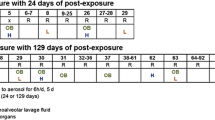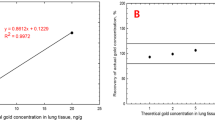Abstract
Inhalation represents the major route of human exposure to manufactured nanomaterials (NMs). Assessments are needed about the potential risks of NMs from inhalation on different tissues and organs, especially the respiratory tract. The aim of this limited study is to determine the potential acute pulmonary toxicity in rats exposed to a dry nanoaerosol of silicon carbide (SiC) nanoparticles (NPs) in a whole-body exposure (WBE) model. The SiC nanoaerosol is composed of a bimodal size distribution of 92.8 and 480 nm. The exposure concentration was 4.91 mg/L, close to the highest recommended concentration of 5 mg/L by the Organisation for Economic Co-operation and Development. Rats were exposed for 6 h to a stable and reproducible SiC nanoaerosol under real-time measurement conditions. A control group was exposed to the filtered air used to create the nanoaerosol. Animals were sacrificed immediately, 24 or 72 h after exposure. The bronchoalveolar lavage fluid from rat lungs was recovered. Macrophages filled with SiC NPs were observed in the rat lungs. The greatest load of SiC and macrophages filled with SiC were observed on the rat lungs sacrificed 24 h after acute exposure. A limited acute inflammatory response was found up to 24 h after exposure characterized by a lactate dehydrogenase and total protein increase or presence of inflammatory cells in pulmonary lavage. For this study a WBE model has been developed, it allows the simultaneous exposure of six rats to a nanoaerosol and six rats to clean-filtered air. The nanoaerosol was generated using a rotating brush system (RBG-1000) and analyzed with an electrical low pressure impactor in real time.








Similar content being viewed by others
Abbreviations
- ALAT:
-
Alanine amino-transferase
- AP:
-
Alkaline phosphatases
- ASAP:
-
Accelerated surface area and porosimetry system
- ASAT:
-
Aspartate amino-transferase
- BALF:
-
Bronchoalveolar lavage fluid
- CNT:
-
Carbon nanotubes
- EDX:
-
Energy dispersive X-ray
- ELPI:
-
Electrical low pressure impactor
- FEG-SEM:
-
Field emission gun scanning electron microscope
- IL:
-
Interleukin
- NM(s):
-
Nanomaterial(s)
- NP(s):
-
Nanoparticle(s)
- PIXE:
-
Particle-induced X-ray emission
- SD:
-
Standard deviation
- XPS:
-
X-ray photoelectron spectroscopy
- WBE:
-
Whole-body exposure
References
Akhtar MJ, Ahamed M, Kumar S, Siddiqui H, Patil G, Ashquin M, Ahmada I (2010) Nanotoxicity of pure silica mediated through oxidant generation rather than glutathione depletion in human lung epithelial cells. Toxicology 276:95–102
Barillet S, Jugan ML, Laye M, Leconte Y, Herlin-Boime N, Reynaud C, Carriere M (2010) In vitro evaluation of SiC nanoparticles impact on A549 pulmonary cells: cyto-, genotoxicity and oxidative stress. Toxicol Lett 198:324–330
Borm P, Klaessig FC, Landry TD, Moudgil B, Pauluhn J, Thomas K, Trottier R, Wood S (2006) Research strategies for safety evaluation of nanomaterials, part V: role of dissolution in biological fate and effects of nanoscale particles. Toxicol Sci 90:23–32
Card JW, Zeldin DC, Bonner JC, Nestmann ER (2008) Pulmonary applications and toxicity of engineered nanoparticles. Am J Physiol Lung Cell Mol Physiol 295:L400–L411
Choi J, Zhang Q, Reipa V, Wang NS, Stratmeyer ME, Hitchins VM, Goering PL (2009) Comparison of cytotoxic and inflammatory responses of photoluminescent silicon nanoparticles with silicon micron-sized particles in RAW 264.7 macrophages. J Appl Toxicol 29:52–60
Froeschke S, Kohler S, Weber AP, Kasper G (2003) Impact fragmentation of nanoparticle agglomerates. J Aerosol Sci 34:275–287
Lin W, Huang YW, Zhou XD, Ma Y (2006) In vitro toxicity of silica nanoparticles in human lung cancer cells. Toxicol Appl Pharmacol 217:252–259
Lozano O, Laloy J, Alpan L, Mejia J, Rolin S, Toussaint O, Dogné J-M, Lucas S, Masereel B (2012a) Effects of SiC nanoparticles orally administered in a rat model: biodistribution, toxicity and elemental composition changes in feces and organs. Toxicol Appl Pharmacol 264:232–245. doi:10.1016/j.taap.2012.1008.1004
Lozano O, Mejia J, Masereel B, Toussaint O, Lison D, Lucas S (2012b) Development of a PIXE analysis method for the determination of the biopersistence of SiC and TiC nanoparticles in rat lungs. Nanotoxicology 6:263–271. doi:10.3109/17435390.17432011.17572301
Magnusson P, Shen Z (2005) Ceramic based nanomaterials for ballistic protection. Nanomater Technol Mil Veh Struct Appl 12:1–8
McCarthy J, Inkielewicz-Stępniak I, Corbalan JJ, Radomski MW (2012) Mechanisms of toxicity of amorphous silica nanoparticles on human lung submucosal cells in vitro: protective effects of fisetin. Chem Res Toxicol 25:2227–2235
Möhlmann C (2004) German activity on the ultra-fine particles in the workplaces. In: First international symposium on the occupational health implications of nanomaterials. http://www.hsl.gov.uk/media/1646/nanosymrep_final.pdf. Accessed 28 March 2012
Myojo T, Oyabu T, Nishi K, Kadoya C, Tanaka I, Ono-Ogasawara M, Sakae H, Shirai T (2009) Aerosol generation and measurement of multi-wall carbon nanotubes. J Nanopart Res 11:91–99
Oberdorster G, Sharp Z, Atudorei V, Elder A, Gelein R, Kreyling W, Cox C (2004) Translocation of inhaled ultrafine particles to the brain. Inhal Toxicol 16:437–445
Oberdorster G, Maynard A, Donaldson K, Castranova V, Fitzpatrick J, Ausman K, Carter J, Karn B, Kreyling W, Lai D, Olin S, Monteiro-Riviere N, Warheit D, Yang H (2005) Principles for characterizing the potential human health effects from exposure to nanomaterials: elements of a screening strategy. Part Fibre Toxicol 2:8
Official Journal of the European Union, Union OJotE (2007) Commission recommendation of 18 June 2007 on guidelines for the accommodation and care of animals used for experimental and other scientific purposes. Notified under document number C(2007) 2525. http://eur-lex.europa.eu/LexUriServ/LexUriServ.do?uri=OJ:L:2007:197:0001:0089:EN:PDF. Accessed 28 March 2014
Organisation for Economic Co-operation and Development, OECD (2009) OECD guideline for testing of chemicals. Acute inhalation toxicity. Guideline 403. Accessed 28 March 2014
Petrovsky GT, Tolstoy MN, Lubarsky SV, Khimitch YP, Robb PN (1994) 2.7-Meter-diameter silicon carbide primary mirror for the SOFIA telescope. In: Stepp LM (ed) Proceedings of SPIE - The International Society for Optical Engineering. Presented at the society of photo-optical instrumentation engineers (SPIE) conference, vol 2199. pp 263–270
Richman JD, Livi KJT, Geyh AS (2011) A scanning transmission electron microscopy method for determination of manganese composition in welding fume as a function of primary particle size. J Aerosol Sci 42:408–418
Sayes CM, Reed KL, Warheit DB (2007) Assessing toxicity of fine and nanoparticles: comparing in vitro measurements to in vivo pulmonary toxicity profiles. Toxicol Sci 97:163–180
Schmoll LH, Elzey S, Grassian VH, O’Shaughnessy PT (2009) Nanoparticle aerosol generation methods from bulk powders for inhalation exposure studies. Nanotoxicology 3:265–275
Sharp PE, La Regina MC (1998) The laboratory rat. CRC Press, pp 1–204
Wong BA (2007) Inhalation exposure systems: design, methods and operation. Toxicol Pathol 35:3–14
Acknowledgements
This work was supported by the Service Public de Wallonie (SPW)—Direction générale opérationnelle-Economie, Emploi et Recherche (DGO6), Département des Programmes de Recherche (Nanotoxico Project, SPW/FUNDP Research Convention N° 516252). O. Toussaint is a Research Associate of the Belgian FNR/FNRS. The authors would like to thank their colleagues Aurélien Nonet, Renaud Vigneron, and Stéphanie Rolin. We would like to express our gratitude to Aline Demortier from Toxicology Labs, Federal Public Service Employment, Labour and Social Dialogue for her technical support with another aerosol analyzer.
Author information
Authors and Affiliations
Corresponding author
Ethics declarations
Conflict of interest
The authors declare there is no conflict of interest.
Additional information
J. Laloy and O. Lozano have contributed equally in the study reported here.
Electronic supplementary material
Rights and permissions
About this article
Cite this article
Laloy, J., Lozano, O., Alpan, L. et al. Limited inflammatory response in rats after acute exposure to a silicon carbide nanoaerosol. J Nanopart Res 17, 346 (2015). https://doi.org/10.1007/s11051-015-3138-7
Received:
Accepted:
Published:
DOI: https://doi.org/10.1007/s11051-015-3138-7




